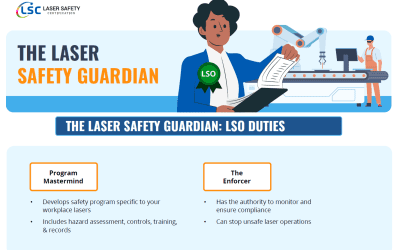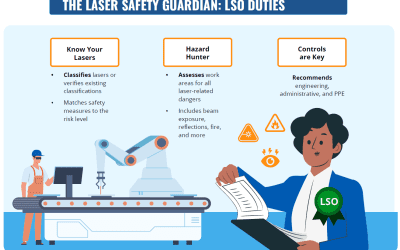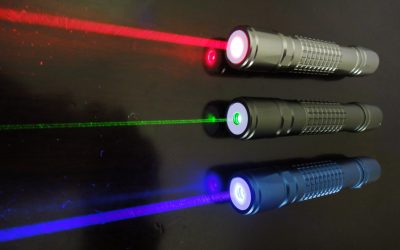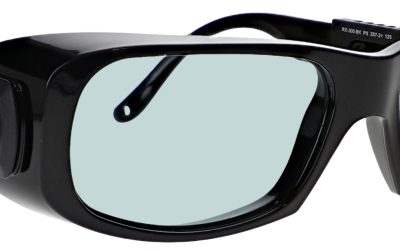The Importance of PPE around Lasers
Are you wearing the right safety goggles? It’s important for use around lasers and can also protect you from the spread of COVID-19 through the eye’s mucous membrane.
When PPE is necessary
Personal Protective Eyewear (PPE) is necessary for Class 3 and 4 laser use where irradiation of the eye is possible. Such eye protection should be used only at the wavelength and energy/power for which it is intended. Eye protection may include goggles, face shields, spectacles or prescription eyewear using special filter materials or reflective coatings (or a combination of both) to reduce exposure below the Maximum Permissible Exposure (MPE) level. Eye protection may also be necessary to protect against physical or chemical hazards.
The following factors should be considered in selecting the appropriate laser protective eyewear:
Laser-Type PPE Considerations
- Wavelength(s) of the laser output
- Potential for multi-wavelength operation
- Radiant exposure or irradiance levels for which protection (worst case) is required
- Exposure time criteria
- Defined Maximum Permissible Exposure (MPE)
- Angular dependence of protection afforded
PPE Property Considerations
- Optical Density (OD) requirement of the eyewear filter at laser output wavelength
- Visible light transmission requirements and assessment of the effect of the eyewear on the ability to perform tasks while wearing the eyewear
- Need for side shield protection and peripheral vision
- Radiant exposure or irradiance and the corresponding time factors at which laser safety eyewear damage (penetration) occurs, including transient bleaching
- Need for prescription glasses
- Comfort and fit
Additional Considerations
- Degradation of absorbing media, such as photobleaching
- Strength of materials (resistance to mechanical shock or trauma)
- Capability of the front surface to produce a hazardous specular reflection
- Requirement for anti-fogging design or coatings
Laser Eye Protection Selection Process
Determine the wavelength of the laser.
- Eye protection is wavelength-specific.
- Eyewear that provides protection for CO2 lasers will not necessarily protect against Nd:YAG lasers.
Determine the maximum anticipated viewing duration.
- Unintentional, accidental exposure to visible lasers (400-700 nm), use 0.25 seconds
- Unintentional, accidental viewing of near infrared (700-1000 nm) beams, use 10 seconds
Determine the maximum irradiance or radiant exposure to which the eye may be exposed.
- If the emergent beam is not focused down to a smaller spot and is greater than 7 mm in diameter, the emergent beam radiant exposure/irradiance may be considered the maximum intensity that could enter the eye.
- If the beam is focused after emerging from the laser or if the beam diameter is less than 7 mm, assume that all of the laser energy/power could enter the eye. In this case, use the columns titled Maximum Output Power/Energy in the table below.
Determine the optical density needed.
- Select the type of eye protection needed.
- Laser eye protection is available in the form of glasses and goggles.
- The lens may be made out of glass or crystalline filter material or plastic.
- Generally, glass or crystalline lenses are recommended for harsh environments, such as areas where solvents and corrosives are used.
Test the eye protection.
- Always check the integrity of the lens before use.
- At very high beam intensities, filter materials become bleached out or otherwise damaged.
- A continuous wave power exceeding 10 W can fracture glass and burn through plastics.
For more information
The PPE selection process above is a basic guideline to follow for laser eye protection. Our Laser Safety Officer Kit is a great tool for teaching the basics of laser safety including protective eyewear to your employees. If you are an LSO or need to become one, go here – https://www.lasersafetycertification.com/products/ for more information. It’s easy to enroll your company and students. You can also check out our FAQ for answers to common questions at https://www.lasersafetycertification.com/faq/.




